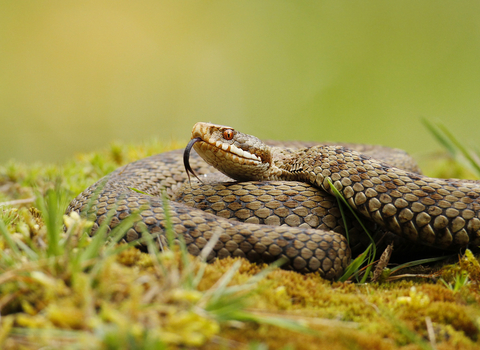
©Jon Hawkins
Adder
Our only venomous snake, the shy adder can be spotted basking in the sunshine in woodland glades and on heathlands.
Scientific name
Vipera berusWhen to see
March to OctoberSpecies information
Category
Statistics
Length: 60-80cmWeight: 50-100g
Average lifespan: up to 15 years
Protected in the UK under the Wildlife and Countryside Act, 1981. Priority Species under the UK Post-2010 Biodiversity Framework.
About
The adder is a relatively small, stocky snake that prefers woodland, heathland and moorland habitats. It hunts lizards and small mammals, as well as ground-nesting birds, such as skylark and meadow pipit. In spring, male adders perform a 'dance' during which they duel to fend off competition to mate. Females incubate the eggs internally, 'giving birth' to three to twenty live young. Adders hibernate from October, emerging in the first warm days of March, which is the easiest time of year to find them basking on a log or under a warm rock.How to identify
The adder is a greyish snake, with a dark and very distinct zig-zag pattern down its back, and a red eye. Males tend to be more silvery-grey in colour, while females are more light or reddish-brown. Black (melanistic) forms are sometimes spotted.Distribution
Found across the country, except for the Isles of Scilly, the Channel Islands, Northern Ireland and the Isle of Man.Did you know?
The adder is the UK's only venomous snake, but its venom is generally of little danger to humans: an adder bite can be painful and cause a inflammation, but is really only dangerous to the very young, ill or old. If bitten, medical attention should be sought immediately, however. Adders are secretive animals and prefer to slither off into the undergrowth rather than confront and bite humans and domestic animals; most attacks happen when they are trodden on or picked up. Instead, they use their venom to immobilise and kill their prey of small mammals, nestlings and lizards.Watch
Adder (https://vimeo.com/271277345)
©Jack Perks
